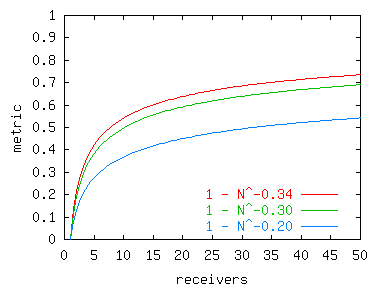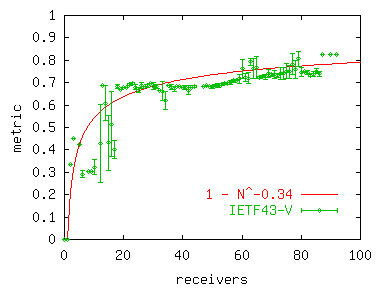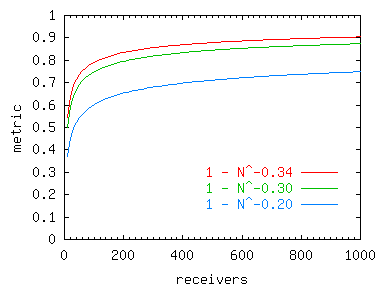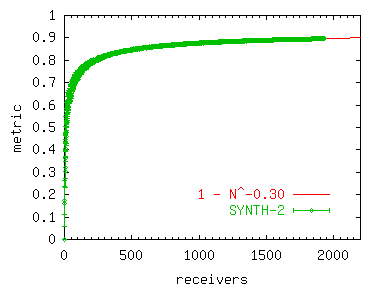
|
|
A Characterization of Multicast Efficiency |
|
Home | Publications | Download | Instructions Synthesized Trees | Efficiency Study | Anatomy Study |
|
In previous work (Globecom '00), we developed a metric to measure multicast efficiency in relation to duplicate unicast streams: L_m = the total number of multicast links in the distribution tree, and L_u = the total number of unicast hops (counting duplicate packets) Delta, then, represents the percentage gain in bandwidth utilization achieved by using multicast rather than unicast. In other words, delta indicates the fraction of duplicate packets multicast removes from the network.
Working from a formula derived by Chuang and Sirbu('98) to price multicast in terms of unicast, we were able to provide and estimate for delta: N = the number of receivers, and epsilon = an efficiency factor This provides us with an estimate for multicast efficiency that depends only on the number of receivers in the multicast group. Graphs of the function for 50 and 1000 receivers with a few values of epsilon are displayed in the next column. |
|

|
|
|

|
|
To determine whether this estimate was accurate for real multicast distribution trees, we measured the metric, delta, for a number of real groups. Furthermore, we explored the metric's dependence on temporal and spatial factors such as receiver duration and inter-arrival times as well as receiver distribution.
The first graph to the left is for a real group where the temporal domain has been stretched by randomizing receiver duration and inter-arrival times. The second graph stretches the spatial domain by using random receiver distributions. To collect this "synthesized" dataset, we traced paths from a local source to a random collection of receivers over the current multicast infrastructure of the Internet. So, although the receiver distribution was random, the underlying topology was not. So, the efficiency estimate holds over a wide range of group dynamics and distributions within a small range of values of epsilon, from -.30 to -.34. The estimate tells us how efficient an inter-domain multicast should be. With even a small number of receivers, multicast out-performs unicast by a wide margin. For 20 to 40 receivers, we can expect a 60-70% increase in efficiency, reaching 80% for 150 receivers. |
|
|
| contact us at robertc@cs.ucsb.edu | updated 05.01.01 |

